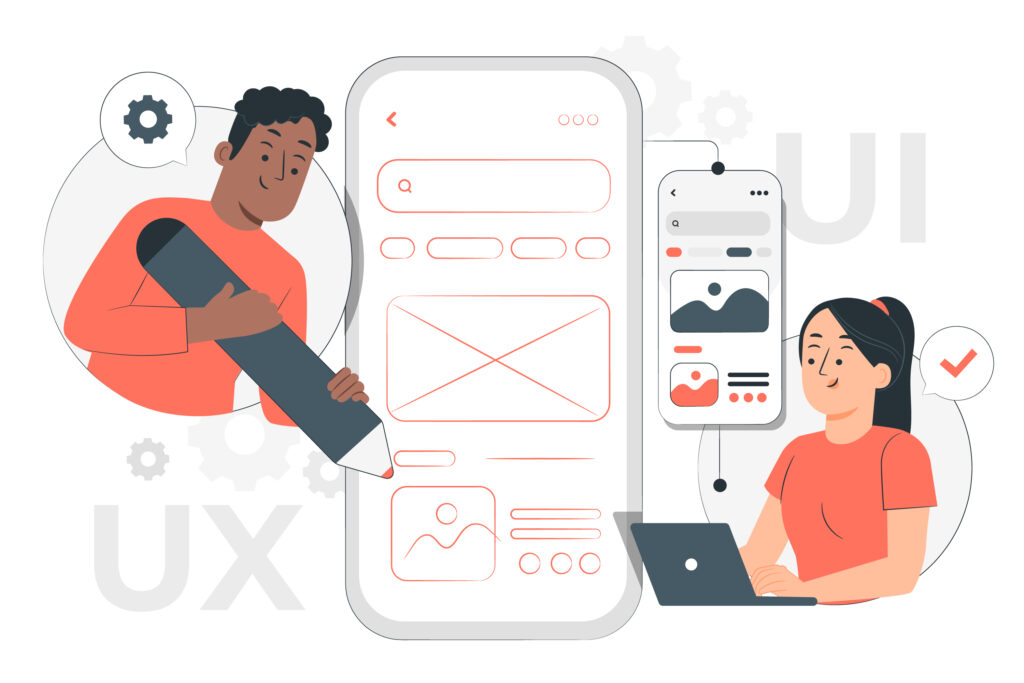In today’s digital age, a website is often the first interaction a customer has with a business. It is not just an online brochure or catalog, but rather a powerful tool to establish a brand, engage with customers, and drive conversions. However, just having a website is not enough. It must be user-friendly, intuitive, and visually appealing to attract and retain visitors. This is where user experience (UX) design comes in. UX design is the process of creating digital products that are easy to use, navigate, and understand.
Research has shown that UX plays a vital role in website success. In fact, a study by Forrester found that “implementing a focus on customers’ experience increases their willingness to pay by 14.4%, reduces their reluctance to switch brands by 15.8%, and boosts their likelihood to recommend your product by 16.6%.”
Furthermore, a study by the Nielsen Norman Group found that websites with good usability had a 135% better customer conversion rate than those with poor usability.
To stand out from the competition and attract and retain customers, businesses need to focus on providing a great user experience (UX) for their website visitors. In this article, we will explore the importance of UX for websites and provide a case study of a company that saw a significant increase in website traffic after improving its UI/UX.

What is User Experience (UX) for Websites?
User experience (UX) refers to the overall experience that a user has when interacting with a website. It encompasses all aspects of the user’s experience, from the design and layout, accessibility, performance to the ease of use and functionality of the website.
In the context of website design, UX design focuses on creating a positive experience for the user. This includes designing an intuitive navigation system, easy-to-use interface, and visually appealing design. The goal is to make the website easy to use and navigate, so that visitors can find what they are looking for quickly and easily.
Why is UX important for websites?
1. User Engagement and Retention
One of the primary reasons UX is important for websites is that it improves user engagement and retention. A well-designed website that is easy to navigate and use can keep visitors on the site for longer periods. By making the website user-friendly and intuitive, visitors are more likely to explore more pages and stay on the site longer. This, in turn, increases the chances of converting visitors into customers.
2. Brand Perception
A website is often the first point of contact between a business and its potential customers. The design and functionality of the website can have a significant impact on how visitors perceive the brand. A poorly designed website can make the brand appear unprofessional and outdated. On the other hand, a well-designed website can make the brand appear modern, trustworthy, and customer-centric.
3. Search Engine Optimization (SEO)
A website’s UX can also impact its search engine ranking. Search engines like Google prioritize websites with good user experience. They take into account factors like page load speed, mobile-friendliness and other UX factors when determining where to rank a website in search results. Websites with a better user experience are more likely to have lower bounce rates, longer visit durations, and higher engagement. These factors contribute to a higher ranking in Google search results and thus higher traffic.
4. Customer Loyalty
A website that provides a great user experience can help build customer loyalty. Customers are more likely to return to a website that is easy to use and provides a positive experience. Loyal customers can also become brand ambassadors and help promote the business to others.
5. Improve conversion rates and revenue
A website with a great UX can help increase conversions, whether that means signing up for a newsletter, making a purchase, or filling out a contact form. When a website is easy to use and navigate, visitors are more likely to take the desired action.
A website with good UX design can also lead to increased revenue. By attracting and retaining customers and improving conversion rates, a company can generate more revenue through its website.
Case Study: A Company that Improved its UI/UX
One company that saw an increase in traffic and revenue after improving its UI/UX is Airbnb. Airbnb is an online marketplace that allows users to rent out their homes or book accommodations in other people’s homes.
In 2014, Airbnb was facing a significant challenge. Although the company had been growing rapidly, it was still struggling to attract new users and increase traffic to its platform. The company’s growth had begun to stagnate. The site’s user experience (UX) was confusing and difficult to navigate, leading to high bounce rates and low engagement. The company’s leadership team realized that they needed to redesign their user experience (UX) in order to make the site more user-friendly and appealing to potential customers.
The first step in the redesign process was to conduct extensive user research. Airbnb’s UX team conducted user interviews, surveys, and usability tests to identify the pain points and challenges that users were facing when using the platform. Based on this research, the team identified several key areas for improvement, including:
Simplifying the booking process: Many users found the booking process confusing and time-consuming. The team decided to simplify the process by reducing the number of steps required to complete a booking.
Improving search functionality: Users were having difficulty finding the properties they were interested in. The UX team focused on improving search functionality to make it easier for users to find the properties that met their needs.
Enhancing visual design: The existing site design was cluttered and difficult to navigate. The team focused on creating a cleaner, more modern design that would be more appealing to users.
Once the redesign was complete, Airbnb began testing the new UX with a small group of users. The response was overwhelmingly positive, with users reporting that the new design was more intuitive, easier to use, and more visually appealing than the old design.
Based on these results, Airbnb began rolling out the new UX to all users. The results were impressive. Within six months of launching the new design, Airbnb saw a 30% increase in bookings and a 20% increase in revenue. User engagement also increased, with users spending more time on the site and viewing more listings.
Overall, the redesign of Airbnb’s UX was a resounding success which led to increased customer retention and ultimately revenue.


